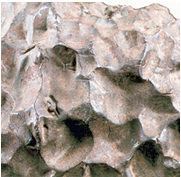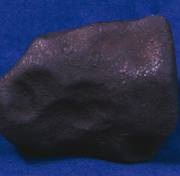Like No Rock on Earth

Enlargement
Regmaglypts on the surface of the Sikhote-Alin meteorite. |
When you see a suspicious rock, different from all those around it, you might wonder if it is a meteorite. Here are a few clues to help you identify a rock from space. Most meteorites are heavier than terrestrial rocks of the same size due to the presence of an iron-nickel alloy or metallic minerals. These metallic components are attracted to a magnet. But be careful, the magnet test is not infallible: some achondrites are not very magnetic.

Enlargement
The Saint-Robert meteorite from Quebec is covered with a thin, dull black fusion crust. |
Recently fallen meteorites carry a reminder of their passage through the Earth's atmosphere: they are covered by a thin fusion crust that is usually dull and black. The fusion crust does not support Earth's climate very well; it erodes and turns brown after a while. Iron meteorites have depressions on their surface. These are shaped like thumbprints and are called regmaglypts. They are created by the differential ablation of various metals during the passage through the atmosphere. The metals that are the least resistant melt and produce these cavities.
If you are able to observe the interior of the supposed meteorite, the presence of chondrites or Widmanstätten figures is a sure sign that it really is a meteorite. These structures are unique to stony meteorites and iron meteorites.
A number of terrestrial rocks and artifacts are often mistaken for meteorites. Ferrous oxide and smelter waste are examples of false meteorites.
|